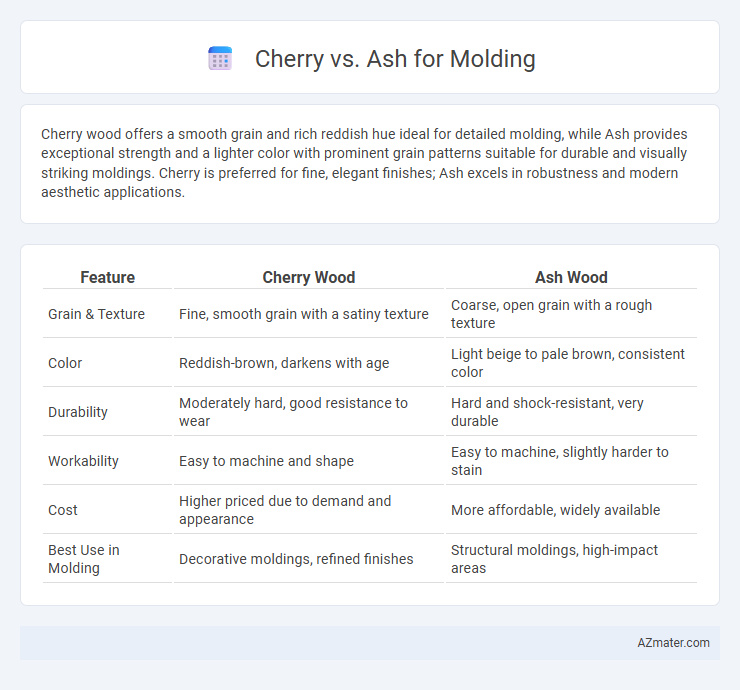Cherry wood offers a smooth grain and rich reddish hue ideal for detailed molding, while Ash provides exceptional strength and a lighter color with prominent grain patterns suitable for durable and visually striking moldings. Cherry is preferred for fine, elegant finishes; Ash excels in robustness and modern aesthetic applications.
Table of Comparison
| Feature | Cherry Wood | Ash Wood |
|---|---|---|
| Grain & Texture | Fine, smooth grain with a satiny texture | Coarse, open grain with a rough texture |
| Color | Reddish-brown, darkens with age | Light beige to pale brown, consistent color |
| Durability | Moderately hard, good resistance to wear | Hard and shock-resistant, very durable |
| Workability | Easy to machine and shape | Easy to machine, slightly harder to stain |
| Cost | Higher priced due to demand and appearance | More affordable, widely available |
| Best Use in Molding | Decorative moldings, refined finishes | Structural moldings, high-impact areas |
Introduction to Cherry and Ash Wood
Cherry wood, prized for its rich, reddish-brown hue and fine, straight grain, is a popular choice for molding due to its smooth texture and exceptional workability. Ash wood features a lighter color with prominent grain patterns, known for its strength and elasticity, making it ideal for durable, resilient moldings. Both woods offer distinct aesthetic and structural benefits, with cherry providing elegance and warmth, while ash delivers toughness and a striking grain appearance.
Characteristics of Cherry Wood for Molding
Cherry wood offers a smooth, fine grain with a rich reddish-brown color that deepens and develops a warm patina over time, making it a popular choice for molding in high-end interior applications. Its moderate hardness and excellent workability allow intricate detailing and a smooth finish, ensuring durability without compromising aesthetic appeal. Cherry's natural resistance to warping and shrinking provides dimensional stability, ideal for precise molding installations in varying humidity conditions.
Properties of Ash Wood for Molding
Ash wood features a coarse, straight grain and a light beige to medium brown color that enhances molding aesthetics. Its high strength-to-weight ratio and exceptional shock resistance make ash ideal for durable, long-lasting moldings. The wood's workability, combined with good nail and screw hold, supports precise, clean installations in detailed molding applications.
Aesthetic Differences: Cherry vs Ash Molding
Cherry molding offers a rich, warm reddish-brown hue that deepens with age, creating an elegant, classic aesthetic ideal for traditional interiors. Ash molding showcases a lighter, creamy color with prominent, straight grain patterns, providing a bright, modern look that complements contemporary design. The distinct color variations and grain structures between cherry and ash dramatically influence the visual impact and style of any space.
Durability and Strength Comparison
Cherry wood offers moderate durability with a fine, uniform texture and good stability, making it resistant to warping and suitable for decorative molding. Ash is known for its superior strength and high resistance to wear, featuring a dense grain that provides excellent durability and impact resistance, ideal for high-traffic areas. Comparing both, ash typically outperforms cherry in strength and durability, making it the preferred choice for molding that demands long-lasting structural integrity.
Workability and Ease of Installation
Cherry wood offers excellent workability due to its fine, even grain and smooth texture, making it easy to shape and sand for precise molding details. Ash provides superior ease of installation because of its strength and flexibility, allowing for durable, secure fitting in various construction environments. Both woods are favored for molding, with cherry excelling in detailed craftsmanship and ash in structural reliability.
Cost Considerations: Cherry vs Ash
Cherry wood generally commands a higher price than ash due to its rich color, fine grain, and greater demand in premium moldings. Ash offers a more budget-friendly option with comparable hardness and durability, making it ideal for cost-conscious projects without sacrificing quality. Choosing between cherry and ash moldings depends on balancing aesthetic preference with project budget constraints.
Maintenance and Longevity
Cherry wood offers superior longevity and low maintenance for molding due to its natural hardness and dense grain, which resists dents and scratches over time. Ash, while also durable, requires more frequent upkeep to prevent wear caused by its coarser texture and higher porosity. Proper sealing and occasional refinishing enhance the lifespan of ash molding, whereas cherry maintains its rich appearance with minimal intervention.
Best Applications for Each Wood Type
Cherry wood, prized for its smooth texture and rich reddish-brown hue, is best suited for intricate interior moldings such as crown and baseboards that benefit from fine detail and a warm finish. Ash, known for its strength and light color with prominent grain patterns, excels in high-traffic molding applications like door and window casings where durability and impact resistance are crucial. For projects demanding both beauty and robustness, selecting cherry enhances aesthetic appeal in formal spaces, while ash provides functional resilience in more utilitarian environments.
Choosing Between Cherry and Ash for Molding
Cherry wood offers a rich, warm reddish-brown tone with a smooth grain, making it ideal for elegant, high-end moldings that age beautifully with time. Ash provides a lighter color with pronounced grain patterns and exceptional hardness, suitable for durable moldings requiring a strong, contemporary look. Choosing between cherry and ash for molding depends on desired aesthetic appeal, hardness requirements, and color preferences aligned with interior design themes.

Infographic: Cherry vs Ash for Molding
 azmater.com
azmater.com